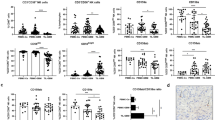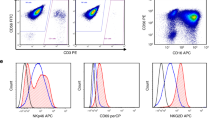Abstract
Infusion of allogeneic NK cells is a potential immunotherapy for both hematopoietic malignancies and solid tumors. Interactions between killer immunoglobulin-like receptors (KIR) on human NK cells and KIR-ligands on tumor cells influence the magnitude of NK function. To obtain sufficient numbers of activated NK cells for infusion, one potent method uses cells from the K562 human erythroleukemia line that have been transfected to express activating 41BB ligand (41BBL) and membrane-bound interleukin 15 (mbIL15). The functional importance of KIRs on ex vivo expanded NK cells has not been studied in detail. We found that after a 12-day co-culture with K562-mbIL15-41BBL cells, expanded NK cells maintained inhibition specificity and prior in vivo licensing status determined by KIR/KIR-ligand interactions. Addition of an anti-CD20 antibody (rituximab) induced NK-mediated antibody-dependent cellular cytotoxicity and augmented killing of CD20+ target cells. However, partial inhibition induced by KIR/KIR-ligand interactions persisted. Finally, we found that extended co-cultures of NK cells with stimulatory cells transduced to express various KIR-ligands modified both the inhibitory and activating KIR repertoires of the expanded NK cell product. These studies demonstrate that the licensing interactions known to occur during NK ontogeny also influence NK cell function following NK expansion ex vivo with HLA-null stimulatory cells.




Similar content being viewed by others
Abbreviations
- ADCC:
-
Antibody-dependent cellular cytotoxicity
- aKIR:
-
Activating killer immunoglobulin-like receptor
- Bw4:
-
HLA-Bw4
- C1:
-
HLA-C1
- C2:
-
HLA-C2
- iKIR:
-
Inhibitory killer immunoglobulin-like receptor
- KIR:
-
Killer immunoglobulin-like receptor
- mbIL15:
-
Membrane-bound interleukin 15
- MHC:
-
Major histocompatibility complex
- NCR:
-
Natural cytotoxicity receptor
- RT:
-
Rituximab
- 41BBL:
-
41BB ligand
References
Berg M, Lundqvist A, McCoy P Jr, Samsel L, Fan Y, Tawab A, Childs R (2009) Clinical-grade ex vivo-expanded human natural killer cells up-regulate activating receptors and death receptor ligands and have enhanced cytolytic activity against tumor cells. Cytotherapy 11(3):341–355. doi:10.1080/14653240902807034
Fujisaki H, Kakuda H, Shimasaki N, Imai C, Ma J, Lockey T, Eldridge P, Leung WH, Campana D (2009) Expansion of highly cytotoxic human natural killer cells for cancer cell therapy. Cancer Res 69(9):4010–4017. doi:10.1158/0008-5472.can-08-3712
Lim SA, Kim TJ, Lee JE, Sonn CH, Kim K, Kim J, Choi JG, Choi IK, Yun CO, Kim JH, Yee C, Kumar V, Lee KM (2013) Ex vivo expansion of highly cytotoxic human NK cells by cocultivation with irradiated tumor cells for adoptive immunotherapy. Cancer Res 73(8):2598–2607. doi:10.1158/0008-5472.can-12-2893
Voskens CJ, Watanabe R, Rollins S, Campana D, Hasumi K, Mann DL (2010) Ex-vivo expanded human NK cells express activating receptors that mediate cytotoxicity of allogeneic and autologous cancer cell lines by direct recognition and antibody directed cellular cytotoxicity. J Exp Clin Cancer Res 29(1):134. doi:10.1186/1756-9966-29-134
Denman CJ, Senyukov VV, Somanchi SS, Phatarpekar PV, Kopp LM, Johnson JL, Singh H, Hurton L, Maiti SN, Huls MH, Champlin RE, Cooper LJN, Lee DA (2012) Membrane-bound IL-21 promotes sustained ex vivo proliferation of human natural killer cells. PLoS ONE 7(1):e30264. doi:10.1371/journal.pone.0030264
Hospital SNU (2000) Phase I/II study of haploidentical natural killer cell infusion in patients with refractory or relapsed malignant melanoma. In: ClinicalTrialsgov [Internet]. National Library of Medicine (US), Bethesda [cited 25 Aug 2015]. https://clinicaltrials.gov/ct2/show/NCT00846833. NLM Identifier: NCT00846833
Center MDAC (2000) A Phase I/II clinical trial testing the safety and feasibility of IL-21-expanded natural killer cells for the induction of relapsed/refractory acute myeloid leukemia. In: ClinicalTrialsgov [Internet]. National Library of Medicine (US), Bethesda [cited 25 Aug 2015]. https://clinicaltrials.gov/ct2/show/NCT01787474. NLM Identifier: NCT01787474
Paz HUL (2000) “LANK-2”: activated and expanded NK cell immunotherapy together with salvage chemotherapy in children, adolescents and young adults with relapsed or refractory acute leukemia. In: ClinicalTrialsgov [Internet]. National Library of Medicine (US), Bethesda [cited 25 Aug 2015]. https://clinicaltrials.gov/ct2/show/NCT02074657. NLM Identifier: NCT02074657
National University Hospital S (2000)A pilot study of autologous ex vivo activated NK cell infusion in the treatment of metastatic nasopharyngeal carcinoma. In: ClinicalTrialsgov [Internet]. National Library of Medicine (US), Bethesda [cited 27 Feb 2002]. https://clinicaltrials.gov/ct2/show/NCT00717184. NLM Identifier: NCT00717184
Burns LJ, Weisdorf DJ, DeFor TE, Vesole DH, Repka TL, Blazar BR, Burger SR, Panoskaltsis-Mortari A, Keever-Taylor CA, Zhang MJ, Miller JS (2003) IL-2-based immunotherapy after autologous transplantation for lymphoma and breast cancer induces immune activation and cytokine release: a phase I/II trial. Bone Marrow Transpl 32(2):177–186. doi:10.1038/sj.bmt.1704086
Qian X, Wang X, Jin H (2014) Cell transfer therapy for cancer: past, present, and future. J Immunol Res 2014:525913. doi:10.1155/2014/525913
Vilches C, Parham P (2002) KIR: diverse, rapidly evolving receptors of innate and adaptive immunity. Annu Rev Immunol 20(1):217–251. doi:10.1146/annurev.immunol.20.092501.134942
Pyo CW, Guethlein LA, Vu Q, Wang R, Abi-Rached L, Norman PJ, Marsh SG, Miller JS, Parham P, Geraghty DE (2010) Different patterns of evolution in the centromeric and telomeric regions of group A and B haplotypes of the human killer cell Ig-like receptor locus. PLoS ONE 5(12):e15115. doi:10.1371/journal.pone.0015115
Gardiner C (2008) Killer cell immunoglobulin-like receptors on NK cells: the how, where and why. Int J Immunogenet 35(1):1–8. doi:10.1111/j.1744-313X.2007.00739.x
Almeida CR, Ashkenazi A, Shahaf G, Kaplan D, Davis DM, Mehr R (2011) Human NK cells differ more in their KIR2DL1-dependent thresholds for HLA-Cw6-mediated inhibition than in their maximal killing capacity. PLoS ONE 6(9):e24927. doi:10.1371/journal.pone.0024927
Moesta AK, Norman PJ, Yawata M, Yawata N, Gleimer M, Parham P (2008) Synergistic polymorphism at two positions distal to the ligand-binding site makes KIR2DL2 a stronger receptor for HLA-C than KIR2DL3. J Immunol 180(6):3969–3979. doi:10.4049/jimmunol.180.6.3969
David G, Djaoud Z, Willem C, Legrand N, Rettman P, Gagne K, Cesbron A, Retiere C (2013) Large spectrum of HLA-C recognition by killer Ig-like receptor (KIR)2DL2 and KIR2DL3 and restricted C1 specificity of KIR2DS2: dominant impact of KIR2DL2/KIR2DS2 on KIR2D NK cell repertoire formation. J Immunol 191(9):4778–4788. doi:10.4049/jimmunol.1301580
Hilton HG, Vago L, Older Aguilar AM, Moesta AK, Graef T, Abi-Rached L, Norman PJ, Guethlein LA, Fleischhauer K, Parham P (2012) Mutation at positively selected positions in the binding site for HLA-C shows that KIR2DL1 is a more refined but less adaptable NK cell receptor Than KIR2DL3. J Immunol 189(3):1418–1430. doi:10.4049/jimmunol.1100431
Litwin V, Gumperz J, Parham P, Phillips JH, Lanier LL (1994) NKB1: a natural killer cell receptor involved in the recognition of polymorphic HLA-B molecules. J Exp Med 180(2):537–543. doi:10.1084/jem.180.2.537
Pittari G, Liu XR, Selvakumar A, Zhao Z, Merino E, Huse M, Chewning JH, Hsu KC, Dupont B (2013) NK cell tolerance of self-specific activating receptor KIR2DS1 in individuals with cognate HLA-C2 ligand. J Immunol 190(9):4650–4660. doi:10.4049/jimmunol.1202120
Kim S, Sunwoo JB, Yang L, Choi T, Song YJ, French AR, Vlahiotis A, Piccirillo JF, Cella M, Colonna M, Mohanakumar T, Hsu KC, Dupont B, Yokoyama WM (2008) HLA alleles determine differences in human natural killer cell responsiveness and potency. Proc Natl Acad Sci USA 105(8):3053–3058. doi:10.1073/pnas.0712229105
Kim S, Poursine-Laurent J, Truscott SM, Lybarger L, Song Y, Yang L, French AR, Sunwoo JB, Lemieux S, Hansen TH, Yokoyama WM (2005) Licensing of natural killer cells by host major histocompatibility complex class I molecules. Nature 436(7051):709–713. doi:10.1038/nature03847
Tarek N, Luduec JL, Gallagher MM, Zheng J, Venstrom JM, Chamberlain E, Modak S, Heller G, Dupont B, Cheung NV, Hsu KC (2012) Unlicensed NK cells target neuroblastoma following anti-GD2 antibody treatment. J Clin Invest 122(9):3260–3270. doi:10.1172/jci62749
Anfossi N, André P, Guia S, Falk CS, Roetynck S, Stewart CA, Breso V, Frassati C, Reviron D, Middleton D, Romagné F, Ugolini S, Vivier E (2006) Human NK cell education by inhibitory receptors for MHC class I. Immunity 25(2):331–342. doi:10.1016/j.immuni.2006.06.013
Delgado DC, Hank JA, Kolesar J, Lorentzen D, Gan J, Seo S, Kim K, Shusterman S, Gillies SD, Reisfeld RA, Yang R, Gadbaw B, DeSantes KB, London WB, Seeger RC, Maris JM, Sondel PM (2010) Genotypes of NK cell kir receptors, their ligands, and Fc receptors in the response of neuroblastoma patients to Hu14.18-IL2 immunotherapy. Cancer Res 70(23):9554–9561. doi:10.1158/0008-5472.can-10-2211
Ruggeri L (2002) Effectiveness of donor natural killer cell alloreactivity in mismatched hematopoietic transplants. Science 295(5562):2097–2100. doi:10.1126/science.1068440
Terszowski G, Klein C, Stern M (2014) KIR/HLA interactions negatively affect rituximab—but not GA101 (obinutuzumab)-induced antibody-dependent cellular cytotoxicity. J Immunol 192(12):5618–5624. doi:10.4049/jimmunol.1400288
Draghi M (2005) Single-cell analysis of the human NK cell response to missing self and its inhibition by HLA class I. Blood 105(5):2028–2035. doi:10.1182/blood-2004-08-3174
Yu J, Heller G, Chewning J, Kim S, Yokoyama WM, Hsu KC (2007) Hierarchy of the human natural killer cell response is determined by class and quantity of inhibitory receptors for self-HLA-B and HLA-C ligands. J Immunol 179(9):5977–5989. doi:10.4049/jimmunol.179.12.8570-a
Smyth MJ, Cretney E, Kelly JM, Westwood JA, Street SE, Yagita H, Takeda K, van Dommelen SL, Degli-Esposti MA, Hayakawa Y (2005) Activation of NK cell cytotoxicity. Mol Immunol 42(4):501–510. doi:10.1016/j.molimm.2004.07.034
Alter G, Malenfant J, Altfeld M (2004) CD107a as a functional marker for the identification of natural killer cell activity. J Immunol Methods 294(1–2):15–22. doi:10.1016/j.jim.2004.08.008
Imai C, Iwamoto S, Campana D (2005) Genetic modification of primary natural killer cells overcomes inhibitory signals and induces specific killing of leukemic cells. Blood 106(1):376–383. doi:10.1182/blood-2004-12-4797
Shimizu Y, Geraghty D, Koller B, Orr H, DeMars R (1988) Transfer and expression of three cloned human non-HLA-A, B, C class I major histocompatibility complex genes in mutant lymphoblastoid cells. Proc Natl Acad Sci USA 85(1):227–231. doi:10.1073/pnas.85.1.227
Alves LGT, Rajalingam R, Canavez F (2009) A novel real-time PCR method for KIR genotyping. Tissue Antigens 73(2):188–191. doi:10.1111/j.1399-0039.2008.01184.x
Schönberg K, Sribar M, Enczmann J, Fischer JC, Uhrberg M (2011) Analyses of HLA-C-specific KIR repertoires in donors with group A and B haplotypes suggest a ligand-instructed model of NK cell receptor acquisition. Blood 117(1):98–107. doi:10.1182/blood-2010-03-273656
Childs R, Berg M (2013) Bringing natural killer cells to the clinic: ex vivo manipulation. ASH Educ Book 1:234–246. doi:10.1182/asheducation-2013.1.234
Liu Y, Wu H, Sheard M, Sposto R, Somanchi S, Cooper L, Lee D, Seeger R (2013) Growth and activation of natural killer cells ex vivo from children with neuroblastoma for adoptive cell therapy. Clin Cancer Res 19(8):2132–2143. doi:10.1158/1078-0432.CCR-12-1243
Cella M, Longo A, Ferrara GB, Strominger JL, Colonna M (1994) NK3-specific natural killer cells are selectively inhibited by Bw4-positive HLA alleles with isoleucine 80. J Exp Med 180(4):1235–1242. doi:10.1016/0198-8859(94)91776-0
Gumperz JE, Barber LD, Valiante NM, Percival L, Phillips JH, Lanier LL, Parham P (1997) Conserved and variable residues within the Bw4 motif of HLA-B make separable contributions to recognition by the NKB1 killer cell-inhibitory receptor. J Immunol 158(11):5237–5241
Lisovsky I, Isitman G, Bruneau J, Bernard NF (2015) Functional analysis of NK cell subsets activated by 721.221 and K562 HLA-null cells. J Leukoc Biol 97(4):761–767. doi:10.1189/jlb.4AB1014-499R
Sawicki MW, Dimasi N, Natarajan K, Wang J, Margulies DH, Mariuzza RA (2001) Structural basis of MHC class I recognition by natural killer cell receptors. Immunol Rev 181:52–65. doi:10.1034/j.1600-065x.2001.1810104.x
Carrega P, Pezzino G, Queirolo P, Bonaccorsi I, Falco M, Vita G, Pende D, Misefari A, Moretta A, Mingari MC, Moretta L, Ferlazzo G (2009) Susceptibility of human melanoma cells to autologous natural killer (NK) cell killing: HLA-related effector mechanisms and role of unlicensed NK cells. PLoS ONE 4(12):e8132. doi:10.1371/journal.pone.0008132
Acknowledgments
The authors thank all healthy donors participating in this study. Thanks also to Dr. Robert DeMars, who provided 721.221 cells, and Dr. Deric Wheeler who shared the empty vector. This research was supported by a Hyundai Hope on Wheels Grant; Midwest Athletes Against Childhood Cancer; NIH Grants R01 CA166105 and R35 CA197078; and a grant from The Stand Up To Cancer Foundation and St. Baldrick’s Foundation.
Author information
Authors and Affiliations
Corresponding author
Ethics declarations
Conflict of interest
The authors have no financial conflicts of interest.
Electronic supplementary material
Below is the link to the electronic supplementary material.
Rights and permissions
About this article
Cite this article
Wang, W., Erbe, A.K., Alderson, K.A. et al. Human NK cells maintain licensing status and are subject to killer immunoglobulin-like receptor (KIR) and KIR-ligand inhibition following ex vivo expansion. Cancer Immunol Immunother 65, 1047–1059 (2016). https://doi.org/10.1007/s00262-016-1864-z
Received:
Accepted:
Published:
Issue Date:
DOI: https://doi.org/10.1007/s00262-016-1864-z




